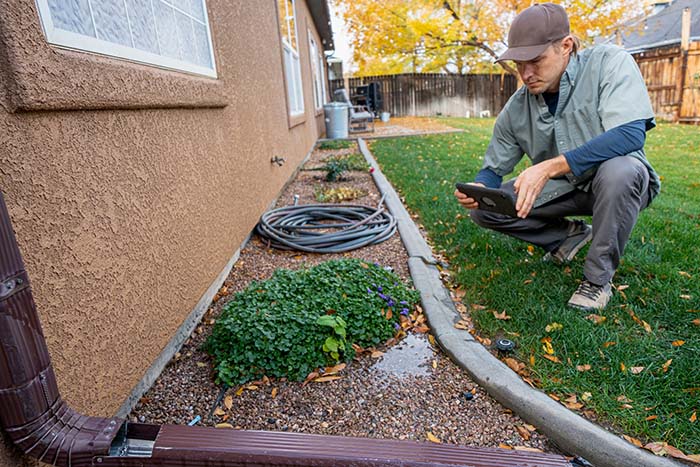What Causes Foundation Issues in the Dallas / Ft. Worth Area?
Top 3 Causes of Slab Foundation Settlement
- poor soil preparation prior to construction.
- plasticity of clay soil.
- poor drainage.
Structures settle into the ground for many different reasons.
The number one reason structures settle and foundation repair is later needed is because of poor soil preparation when the structure was built. The builder fails to prepare the soil before the concrete is poured. The soil, once it is graded, no longer remains at it’s NATURAL DENSITY. It is now disturbed, and is loose and porous. The contractor grades the property to level out the lot, sometimes cutting into a hill at one side and filling up the low spots at the other side. He rarely compacts this soil to it’s natural density when he grades it down. The slab is poured level, but the homeowner soon sees his beautiful home start to develop cracks in the brick, cracks in the sheetrock, and the bathroom tile. Doors will not shut and some cannot lock. What happened?
What has happened is that the loose un-compacted soil compacted on its own, and the slab settled into the ground. Un-compacted fill dirt will compact when it gets dry or when it gets wet, bringing the structure down with it. Once a Bedrock foundation repair specialist installs supports deeper into the ground to reach undisturbed soil, soil that is naturally compacted at it’s natural density, it is then strong enough to support most structures. On loose soil that is un-compacted, even a light small shed will soon settle.
Some sub-contractors may have water and moisture inside their trenches before the concrete is poured, and they pour the concrete anyway. It looks good at the time, and they didn’t have to spend any time and money digging the wet muddy soil out of their trenches. No damage is done until the new homeowner starts to see cracks and damage. The homeowner is faced with an unforeseen foundation repair expense, as well as interior damages and landscape damage. The soil again was not prepared properly before the concrete was poured.
![]()
SOLUTIONS – How to prevent foundation problems before construction of your new home or building:
A foundation/structural engineer and an architect should be involved in the building process from the beginning of construction to protect the future owner.
A foundation/structural engineer can insist on seeing compaction tests provided by the builder to insure all the soil is properly compacted before allowing any concrete to be poured. This should be done before concrete driveways and sidewalks are poured as well.
The architect should visit the construction site and prepare plans to construct the home high enough to insure proper water drainage, and then the foundation/structural engineer should be involved to verify that the builder did in fact follow the architect’s plans.
The foundation/structural engineer can also inspect the trenches for standing moisture and wet spots, and request that the wet soil be removed and the area properly compacted before concrete is installed.
Of course, foundation/structural engineers and architects charge a fee, but those fees are much less than future foundation repair fees, and repairing crack damage fees.
Please call our sister company, Bedrock Engineering, LLC, for prices on hiring a Registered Professional Foundation/Structural Engineer.
![]()
The number two reason foundations settle is because of the plasticity of clay soils. The clay will swell when it gets wet, and it will shrink when it dries. This swelling and shrinking will WORK the weight of the structure down into the ground. Over time, the foundation will remain more settled than it has risen, leaving the homeowner with an unleveled home and doors that stick.
If the homeowner can maintain the moisture of the soil under the foundation at a constant level, and there will be no swelling and shrinking, but during extreme dry spells that is sometimes impossible.
The homeowner, when undergoing a dry spell, must first water the foundation according to Bedrock’s rules in our Maintenance Procedures here, but must also prevent water from ponding around the foundation as well, to prevent swelling of the soil.
Plasticity is the ability of the soil to shrink and swell. The higher the plasticity of the soil, the more apt the soil is to rise up and then settle down. Some of the highest soil plasticity in the world is in North Texas. There are also strong clay soils mixed into most of the southern United States and the Midwest. One side of your house may have more clays than the other side, and one neighbor’s foundation may be sitting on more clay than the other neighbor’s, which accounts for some homes experiencing more foundation problems than others.
![]()
The third main reason for foundation settlement is poor drainage. Water must never pond around a foundation. The soil around the foundation must always shed water away from the structure. We always say, to fix the foundation you must first fix the drainage. Water is the enemy. It can wash out around foundation supports, but it can also cause the clays to swell and shrink, damaging the foundation. Also, If there is too much moisture in the soil, it can reach a saturated point where it will no longer support the weight above it.
If you think you have a moisture problem under or around your home, call our sister company, Bedrock Drainage Corrections, LLC, and they can design a drainage correction plan to collect the moisture and reduce the potential of any future moisture damage.



 © Copyright 2024. All Rights Reserved. Bedrock Foundation Repair, LLC 1018 Fletcher St, Dallas, TX 75223 (214) 824-1211.
© Copyright 2024. All Rights Reserved. Bedrock Foundation Repair, LLC 1018 Fletcher St, Dallas, TX 75223 (214) 824-1211.
Leave A Comment